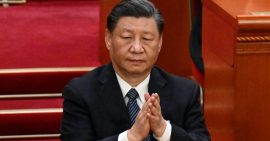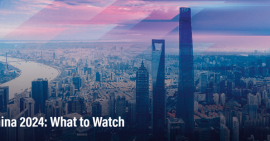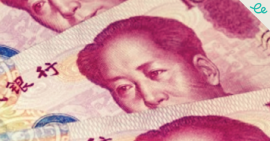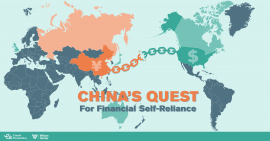How The Light Gets In Festival 2022
Special Event
Enodo Economics director of geopolitical and intelligence analysis Nigel Inkster took part in ‘How The Light Gets In’ Festival
Description
The rise of China has for decades been watched from the West with mistrust. With Xi Jinping making belligerent moves from the South China Sea to the Indian border, tensions have been mounting. Then in February, China and Russia announced a new global order and endorsed respective territorial ambitions in Taiwan and Ukraine. Days later Russia invaded. With Xi declaring to ‘reunite China’ by any means necessary, the threat is overt.
The ancient Chinese philosopher Sun Tzu declared ‘in peace prepare for war’. Should this be Western strategy? Should the West go further and extend sanctions to China? And how should the West respond if China either directly aids Russia in Ukraine or embarks on its own military adventure? Or are the threats overblown and preparing for war a dangerous strategy that risks an arms race and an unimaginably terrible conflict?
Nigel Inkster’s speech
‘The 1990s were a period of optimism. The Soviet Union was no more. And China, having achieved a rapprochement with the USA and put the ideological excesses of the Cultural Revolution behind it, seemed focused to the exclusion of all else on developing its economy.
An “end of history” mindset took hold among western politicians amid a conviction that the liberal democratic mode of governance had comprehensively manifested its superiority. Authoritarian regimes were being replaced with democracies. The spectre of state-on-state warfare had receded and the possibilities of economic and humanitarian progress seemed limitless.
But it turned out that what we had done was to exchange one large, slow moving though potentially existential threat for a set of new threats, none of which was in and of itself existential but which collectively aggregated up into a set of problems that never seemed to get resolved and just kept on growing.
One region that I only tangentially touched on in my first lecture was particularly salient in this regard, namely the Islamic World. Large parts of this region had gone from being part of the Ottoman empire to protectorates – read colonies – of the European powers before attaining independence in the 1950s.
Some states, notably Egypt, Syria, Iraq and Algeria, moved away from their Islamic origins in favour of an ideology of Arab socialism while others, notably Saudi Arabia retained their Islamic heritage.
By the 1970s it was becoming clear that Arab Socialism was a false god that had led to entrenched authoritarian elites with little interest in furthering the well-being of their populations. In the absence of legitimate outlets for expressing dissent, those who felt disadvantaged by the system under which they lived sought refuge in the only available alternative of political Islam.
In 1979 the Islamic world underwent a paradigm shift though its significance was not fully appreciated at the time. Three key events happened that year: the occupation of the Great Mosque in Mecca by a group of Islamist extremists; the Iranian Revolution in which the Shah, long seen as the US gendarme in the Middle East, was overthrown and replaced by a Shia theocracy; and the Soviet invasion of Afghanistan to support what by then was a fraternal socialist regime (strictly speaking, the Soviet invasion of Afghanistan began at the end of 1978 but that is close enough for our purposes).
Those events cast a long shadow. Shaken to the core by the occupation of the Great Mosque, and humiliated at having to rely on French special forces to help them dislodge the occupiers, the ruling House of Saud made what amounted to a Mephistophelian compact with Saudi Arabia’s ultra-conservative religious establishment.
As a result, Saudi Arabia began a massive campaign of global mosque building and proselytising, promoting an extreme and uncompromising version of Wahhabist Islam that led to growing radicalisation in states which practiced a less rigid form of Islam.
Meanwhile, the establishment of a theocratic regime in Iran reignited a long-standing schism between Sunni and Shia Islam as well as giving rise to an antagonism between the USA and Iran that remains to this day.
The Soviet invasion of Afghanistan led to a massive pushback from the Islamic world with many volunteers from Islamic states flocking to Afghanistan to fight with Afghan anti-Soviet resistance forces – the mujahidin. Most of them ended up in neighbouring Pakistan and relatively few ended up doing any fighting in Afghanistan. One of these volunteers, who didn’t do any fighting but provided the mujahidin with substantial financial and logistic support was a certain Osama bin Ladin.
At that point the USA and its allies, having identified an opportunity to weaken the Soviet Union were also doing whatever they could to support the mujahidin through financial and logistic support. In due course this extended to supplying the mujahidin with man-portable Stinger ground to air missiles which denied the Soviets air supremacy and contributed greatly to their withdrawal in 1989.
The Soviet departure from Afghanistan left neighbouring Pakistan playing host to numerous foreign fighters from all around the Islamic world, many of whom were regarded as outlaws in their countries of origin. Most aspired to return to their own countries and continue the fight against what they saw as oppressive and un-Islamic regimes.
Osama bin Ladin’s genius came through the realisation that if this happened, the jihadist momentum created by the victory over the Soviets in Afghanistan would be dissipated. He therefore set up a new movement called al Qaeda – the Base – as an umbrella group whose objective was to overthrow what were perceived as the apostate regimes in countries like Egypt and Saudi Arabia which depended for their survival on US support.
Al Qaeda’s focus should be on forcing the USA – the far enemy – to withdraw from the Islamic world following which the apostate regimes – the near enemy – could be overthrown and replaced with a Caliphate whose authority would extend over all the historic Muslim lands.
The dissolution of the Soviet Union in 1992 deprived the Soviet client regime under Najibullah of support. A civil war broke out and Kabul fell first to the Northern Alliance then, in 1996, to the Taliban, a group made up of students who had studied in religious madrassas in Pakistan. Under the Taliban, who enforced an extreme version of sharia law, Afghanistan became the headquarters of Terror International with jihadist groups from around the Islamic world flocking to set up bases there. In this situation al Qaeda became primus inter pares with the leaders of many – but not all- other groups swearing baya’at- loyalty to bin Ladin.
Meanwhile al Qaeda’s head of operations Khalid Sheikh Mohamed had begun to undertake a succession of transnational terrorist plots targeting the USA and western interests: the first attack on the Twin Towers, the East African bombings, an assassination attempt on the Pope and Operation Bojinka, an unsuccessful attempt to detonate bombs on a dozen international airliners over the Pacific Ocean.
These plots, and many more that were to come, had common characteristics. They were planned in one location, put together in other locations and executed in a third. And they took advantage of the fact that advances in modern Information and Communications Technologies and a resumption of globalisation meant that international communications and international travel, formerly expensive luxuries, had by then come within reach of ordinary people. And the terrorists proved particularly adept at utilising these new communications media both to plot and to proselytise.
And this brings us to 9/11, the destruction of the Twin Towers in New York. To say this was a seminal moment in international relations would be a massive understatement.
For the USA it had long been an article of faith that the US mainland was inviolable and for its security to breached in this way was not just an affront but also a serious blow to its standing as the unchallenged global hegemon. It would take far too long to catalogue how the so-called Global War on Terror launched by the Bush administration in the wake of 9/11 has played out: note that I say “has played out” because the threat from transnational jihadist terrorism is continuing and anyone who thinks otherwise has simply not been paying attention.
The threat has undergone a series of changes: from transnational terrorist plots planned and orchestrated from safe havens – Afghanistan, Pakistan, the Islamic State Caliphate in Syria; through do-it-yourself terrorism by single actors radicalised on-line; to a focus on ungoverned or contested spaces in the Sahel – and now again Afghanistan following the withdrawal of the USA and NATO after a twenty-year period of engagement.
States are rarely well-positioned to deal with terrorism when it first manifests. The unpredictable and episodic nature of terrorist attacks creates fear, uncertainty and vulnerability and can erode popular confidence in governments. And terrorist groups are far more effective if they have safe bases beyond the reach of the state under attack.
The transnational nature of Islamist jihadist terrorism amplifies that sense of vulnerability as does the alien nature of the ideology that informs it. And in a world where few states do not have significant Islamic diaspora communities, the jihadist terrorist phenomenon can lead to a sense of an enemy within with obvious impact on community relations, especially if these diaspora communities are not well-integrated into wider society. But the nation state remains a powerful entity and can, with time and patience usually prevail.
The road to success generally involves significant missteps, including overreaction and resort to coercive measures that ultimately prove self-defeating. And so it has been with the US-led GWOT with its emphasis on a military response and resort to techniques, including enhanced interrogation – for which read torture, extraordinary rendition, black detention centres and prolonged detention in Guantanamo Bay without access to judicial process all of which seriously damaged the US reputation in the Islamic world and beyond.
It didn’t help that a number of repressive regimes sought top-cover from the US government for their own domestic excesses by presenting these as their contribution to GWOT. There were of course many positives as well. The overthrow of the Taliban and al Qaeda’s ejection from Afghanistan meant that their domination of signals intelligence in particular made it possible to catch up and, over time, get across the communication links of terrorist groups tthe point where complex terrorist operations became much harder to plan and conduct.
Nations with limited intelligence capabilities were obliged by the pressure of events to up their game. And effective international coordination became underwent significant improvements.
And this is where I need to undertake a brief detour into technology to clarify and amplify what I just said.
At the time of 9/11 there were only a handful of intelligence agencies able to collect intelligence on a global level and this was particularly true for signals intelligence. At that point most international communications were being transmitted by microwaves and were in effect freely accessible to any organisation that was geographically positioned to collect them – and had the powerful Cray computers needed to triage the huge volumes of data and sort the wheat from the chaff.
In practice that meant the Five-Eyes, whose wide geographical distribution was a huge advantage – and to a lesser extent the Soviet Union. Most of these communications were unencrypted and those that were encrypted used ciphers that had not evolved significantly from the era of World War II, so were well understood and easily broken (it should be mentioned that up to this point governments had exercised a virtual monopoly on encryption and actively discouraged competition from the private sector).
But the advent of the Internet changed all that as communications were increasingly channelled through fibre optic cables. Moving from analogue to digital communications posed a huge challenge and well into the first decade of the 21st century it was by no means clear that it would even be possible.
But this was where GWOT came in. The imperative of identifying terrorist groups and frustrating transnational terrorist plots proved a powerful catalyst to getting on top of the problem. And the USA and its allies had significant advantages as first movers in this field, starting with the fact that at this point most Internet companies were American. And the fibre optic cables that carried data mostly transited either the USA or Britain – a holdover from the days when Britain had dominated the laying of telegraphic cables around the planet. The information from these cables could be acquired covertly by tapping into them or done with the active collaboration of these companies which in the main they were happy to provide – until in 2012 the rogue NSA contactor Edward Snowdon divulged the details of this collaboration.
The outcome of this was that the Five-Eyes were able to sift through vast data sets to identify individuals who didn’t want to be found and connections between them that they sought to conceal. This has been misrepresented as mass surveillance and those who sustain this position are unlikely to be dissuaded from the idea that governments are using this capability as a means of social control – which is in fact the case in authoritarian states such as China and Russia but not in liberal democracies.
The reality however is that the real mass surveillance has remained the province of private sector technology companies who had learnt that the easiest way to make money was by commoditising the information of their users to enable retailers to undertake highly personalised advertising based on a more detailed and complete understanding of the individual than he or she might have themselves.
But to return to GWOT which would prove to have far-reaching geo-political consequences. The USA spent over one trillion dollars fighting jihadist terrorism and the so-called “forever wars” in Afghanistan and Iraq – though in reality the latter were not so much wars as colonial security policing operations of the kind the British had routinely conducted during the 19th and early 20th centuries.
One consequence was that US and other western military and intelligence communities were focused on the jihadist challenge to the point where other emerging challenges received insufficient resources and attention, in particular the risk of state-on-state conflict which at that point was seen as a remote contingency. And of course it didn’t help that the US made its life much harder with the invasion of Iraq in the mistaken belief that the overthrow of Saddam Hussein would usher in an era of democracy in the Middle East.
In the event what it did was to give global jihadism a shot in the arm while inadvertently opening up more strategic space for Iran than it could have dreamt of. Meanwhile other strategic actors were taking advantage of US distraction to pursue their own strategic interests in ways at odds with US and western interests. And learning about US vulnerabilities and how to exploit them.
First and most consequential of these actors was China, a country with which the US had always had a complex relationship dating back to when the country was forcibly opened up to international trade by the British. US merchants were as enthusiastic about the opium trade as their British counterparts but overall the USA, ideologically opposed to imperialism, also adopted a more altruistic approach to China, investing in educational and medical initiatives. Migrant Chinese workers also formed a significant part of the workforce that built the Pacific railway that opened up the American West – though subsequently the US Congress passed legislation banning Chinese immigration.
In World War II the US provided China, which had been at war with Imperial Japan since 1937, with large volumes of materiel to prosecute the war. And during the ensuing civil war in China between the Nationalists and the Communists, the US had been active in brokering peace negotiations.
Following the Communist victory in the civil war, US-China relations essentially collapsed. Diplomatically the US continued supporting China Kai-shek’s Nationalist forces who had fled to Taiwan. Militarily the two countries fought first a full-scale war in the Korean peninsula and then a proxy war in Vietnam.
And under Mao Zedong’s direction China supported communist movements in countries that included Malaysia, Indonesia and Thailand. Initially China had received much economic and military support from the Soviet Union. But following the death of Stalin and Khrushchev’s secret denunciation of Stalin’s excesses relations deteriorated to breaking point. And in 1969 Chinese and Soviet forces clashed along their common border in a conflict that could easily have gone nuclear. By that point China was isolated, impoverished and angry.
President Richard Nixon and his National Security Adviser Henry Kissinger saw strategic benefit in taking advantage of the Sino -Soviet split with Kissinger arguing that at any one time, US relations with either the Soviet Union or China should be better than relations between these two countries.
The result was a rapprochement the primary focus of which was to combat Soviet military expansion. Initially the focus was on intelligence cooperation with the USA setting up two signals intelligence bases in China’s far west to monitor Soviet nuclear and missile tests. But as the madness of the Cultural Revolution gave way in 1978 to Deng Xiaoping’s strategy of the Four Modernisations the relationship became more focused on economic co-operation.
The expectation was that such cooperation would lead to a China that was more open and, if not liberal, then at least less offensively authoritarian. And initially it seemed to be working.During the 1980s China underwent a period of bold experimentation in its search for modernisation during which it seemed that no ideas were off the table.
But in 1989, just as Eastern Europe was about to abandon Communism, the Chinese Communist Party deployed violence in its own capital to suppress a Democracy Movement led by the nation’s students – making clear that the Communist Party would do whatever it took to retain its hold on power something which very much remains the case.
This led to the imposition of US sanctions but for the USA China was too important to lose and there was a quick return to normality. During this period China followed a strategy articulated by Deng Xiaoping in twenty-four characters that became known as “hide and bide”. China’s focus on economic modernisation meant that it effectively abdicated from having any kind of foreign policy and was content to appear as a status quo power happy to benefit from US international security goods.
To cut a very long story short China evolved to become the workshop of the world, its economy turbocharged by entry to the World Trade Organisation in 2001.
The implications of this move were significant. Western businesses flocked to China to take advantage of the cheap land and labour and other benefits on offer with the result that much western manufacture was off-shored, adding significantly to a growing wealth gap in the USA and other western states.
And creating single points of failure in global supply chains, something that would come back to bite us when the COVID pandemic broke out. China’s entry to the WTO was also instrumental for setting the conditions for the 2008 financial crisis, something that is often overlooked. The WTO operates on the presumption of open markets but China only opened its markets selectively, refused to allow the free movement of capital, controlled the costs of borrowing and energy and privileged the state sector.
The result was an unmanageable savings glut that initially seemed to benefit US consumers and enabled the US government to sustain expensive overseas military operations without needing to tax its population.
But eventually US consumers reached a limit on what they could borrow and the party came to an end. None of this is to detract from the responsibility of western bankers, some of whom should be serving jail time for their criminally negligent behaviour. But it does illustrate the difficulties involved in reconciling two very different economic and financial systems in a highly integrated world.
By then, latent tensions between the USA and China had begun to come to the surface. A particular bone of contention was the issue of Taiwan with which China sought reunification.
Prior to normalisation of relations with the PRC the USA had maintained diplomatic relations with the Nationalist regime that had retreated to Taiwan, as island that was nominally part of China but which had only been administered by it for brief periods. The Nationalists had operated a regime every bit as authoritarian as that of the PRC but by the mid-1990s Taiwan was in the process of moving to become a vigorous democracy.
When in 1995 Taiwan held its first ever presidential election China’s military undertook as series of military exercises culminating in firing ballistic missiles in the Taiwan Strait in an effort to intimidate Taiwanese voters. In response the Clinton administration dispatched two carrier battle groups to the region to cool tensions. At that point China’s military, still in the foothills of modernisation, lacked the capacity to discover that these carrier battle groups had been despatched until they actually turned up in the Taiwan Strait.
But this situation gave the People’s Liberation Army a focus for modernisation based on the development of what the Americans, though not the Chinese themselves called Anti-Access- Area Denial capabilities – essentially the ability to keep the US out of theatre long enough to accomplish their goal of reunification.
This process was aided by the fact that the dissolution of the Soviet Union and the resolution of all outstanding border disputes with Russia meant that China no longer had to devote significant military resources to defending its land borders and could concentrate on developing its maritime capabilities – which it has done to remarkable effect, building a fleet of warships that in absolute numbers is larger – though not heavier – than that of the USA.
Since then we have seen China’s military evolve from a low-tech mass mobilisation force unable to project military power beyond its borders into a modern, technology enabled all-arms force capable of conducting joint operations and on its way to becoming a peer competitor of the USA.
As China got richer and more powerful, so its readiness to live under US hegemony diminished.
The 2008 global financial crisis was for China’s leadership a moment of epiphany suggesting that the so-called Washington Consensus was a false god. From that point relations progressively deteriorated and in 2012, when Xi Jinping was appointed CCP Secretary-General it became clear that China was embarked on a very different course from what the USA had imagined when it began the process of engagement. Xi’s vision for China was encapsulated in the China Dream and the Great Rejuvenation of the Chinese Nation – in effect a return to the era when China was globally pre-eminent.
Up to that point US strategy towards China could be characterised as “congagement” – a combination of containment and engagement. But in response to a more assertive China ready to challenge the US-led post World War II global order, the focus became increasingly one of containment, culminating in 2018 in the Trump administration’s trade and tech wars and indications that the USA was looking to promote regime change in China.
The contestation between the USA and China is based on values and ideology. China combines a Marxist-Leninist political structure with a sense of national exceptionalism rooted in its image of itself as a unitary civilisation spanning 5,000 years and occupying a central position in the world. It is also heir to a Confucian philosophy that prizes order, hierarchy and social conservatism.
In essence to use Karl Popper’s term, a closed society in contradistinctions to the USA which is a quintessentially open society. China views the USA as a civilisation in terminal decline and its current leadership believes that liberal democracy is simply not fit for purpose in dealing with a growing and fast-evolving series of global challenges. It believes that it will overtake the USA economically and in terms of technology and has a detailed strategy for doing so.
It has also articulated an alternative model of global governance based on the vague formulation A Community of Common Destiny for Mankind which it presents as capable of accommodating different political and values systems and the interests of states in the developing world that did not exist when the current US-led order was established.
And the Belt and Road Initiative, the main transmission mechanism for enabling this vision which has the aim of connecting China with global markets on China’s terms. Self-serving though this narrative may be, it nonetheless does have resonance with a global south that feels neglected and disadvantaged by the USA and its allies and perceives itself to be a beneficiary of Chinese economic and technological collaboration.
The USA has come to see China as a revisionist power seeking to challenge US hegemony – though this is not a term US policy-makers care to use.
Within a fractious and polarised US political elite, the need to contain China and frustrate its ambitions is the one subject that commands bipartisan consensus. There are no political prizes for being soft on China. An older generation of Sinologists, who learnt their craft at a time when circumstances dictated a degree of humility no longer get a hearing while a younger generation of Sinologists, talented though they are have grown up with an unshakeable assumption of US supremacy.
The nest result of all of this is that the two sides, to the extent that they talk at all, are talking past each other, lecturing rather than negotiating.
China is engaged in a competition with the West that involves all levers of power short of war. The contest plays out in diplomacy, trade, culture and technology. Technology is particularly important. China was slow to adopt the Internet but quick to appreciate both its importance for economic development and the risks it poses in terms of its potential to ve dictates a .vector for subversion.
Initially nobody thought that China would be able to tame the Internet but China proved everybody wrong. It has successfully harnessed its growing technology capabilities to create a techno-security state that may prove to be the “secret sauce” that keeps it in power.
The acquisition of advanced cyber capabilities has also transformed the performance of China’s intelligence services who now have signals intelligence collection capabilities on a par with the Five-Eyes but without the ethical and legal constraints under which the latter operate.
China is in a race with the USA to dominate global standards in a range of advanced seeking to diminish its still considerable reliance on US technologies -though this will not be easy given the level of entanglement that exists within the global tech sector.
Relations between the USA and China have become ever more zero-sum with a real risk that the world’s two largest economies, deeply entangled for the last thirty-five years, will decouple in the areas of the economy and technology , while diminishing the likelihood of cooperation on major global issues such as climate change and pandemic prevention.
Taiwan has become the epicentre of this contestation with China determined to recover the island preferably by peaceful means but if need be by force, and the USA brigading an international alliance of countries that include Japan, India and Australia to constrain China’s ambition and providing Taiwan with ever more materiel for its own defence while maintaining a deliberate posture of strategic ambiguity over whether it would actively intervene in Taiwan’s defence in the event of conflict.
In the event that Taiwan was taken by China the geo-political implications would be profound. Taiwan forms part of the First Island Chain, a line of islands opposite the Chinese coast stretching from Japan through the Philippines to East Malaysia, all states that are US allies.
If the FIC were to be breached, China would be free to expand into the Western Pacific and the USA would be forced into a retreat. US allies in the Western Pacific would have to reach an accommodation with China while the USA, though remaining a substantial global power, would be substantially weakened.
And if the USA were to go to war with China over Taiwan, the implications for the entire planet would be immense. For today we find ourselves in an era of systemic risk in which events in one part of the world have pervasive impact far beyond the locations in which they occur.
Nowhere is this more clearly illustrated than in the current conflict that is taking place between Russia and Ukraine. This war is a reflection of the fact that since the dissolution of the Soviet Union, Russia, a country suffering economic and demographic decline, had not become reconciled with its post-imperial status while nurturing a sense of grievance about the outcome of the Cold War.
This sense of grievance is understandable given the way that living standards collapsed in the immediate aftermath of the Cold War with a planned economy being replaced by a form of gangster capitalism all too often aided and abetted by western commercial interests. And by the fact that senior US politicians routinely disparaged Russia and denied it the recognition as a major power that it sought.
Vladimir Putin who took over the presidency in 2000 in a deal designed to protect the interests of Boris Yeltsin and his family was well-received by the Russian people because he was able to impose order by drawing on the symbiosis that had long existed between the Russian intelligence services of which Putin had been a member with organised criminal groups.
The result was a kleptocratic regime but one that initially, thanks to rising energy prices, did improve living standards for ordinary Russians.
Not long after assuming office, Putin convened a meeting to discuss what direction Russia should take now that it had lost its empire. One suggestion was to look to the example of Britain, a former imperial power that nonetheless seemed to be faring well. Putin forcefully rejected this suggestion, arguing that Russia was a very different case and had to choose a different path.
In particular Putin could not be reconciled to the loss of Ukraine, both because of its place in Russia’s creation myth but also for more prosaic reasons. As the British historian Norman Stone put it, with characteristic lack of diplomacy, “With Ukraine, Russia is the United States. Without it, it is just Canada: mostly snow.”
We are now witnessing Russia, a revisionist state that sees its own security as a function of everyone else’s insecurity, attempting through its “special military operation” to rebuild its imperialist aspirations. And here Vladimir Putin and Xi Jinping are motivated by a similar vision. A world in which the USA is no longer the global hegemon and which is dominated by a small number of major powers each with its own sphere of influence in which it can act unconstrained by customary international law. In essence a world in which might is right and small countries face the situation portrayed by the Greek historian Thucydides in the Melian dialogue: the strong do what they will and the weak suffer what they must. If not empire, then something very similar in terms of effect.
It is of course one thing to aspire to such a world and another to bring it into being.
It is now clear that Vladimir Putin’s gambit has failed and a much-vaunted programme of military modernisation has proven to be a Potemkin exercise, hollowed out by a combination of massive corruption and institutional rigidity.
It has galvanised the West and given the lie to the mantra repeated by the Chinese Communist Party that “the east is rising, the west is in decline.” And China, for all its supposed commitment to a relationship with Russia without limits, has confined itself to giving Russia moral and political but little practical support.
But looking beyond the immediate response to Ukraine, it is becoming increasingly evident that the tectonic plates of a global order that has persisted since the end of World War II are shifting.
We are in effect back in the Kindleberger Trap. The USA remains unreconciled to a loss China, the only other country potentially capable of exercising global hegemony has no desire to do so in the same way the US has done, in particular in relation to providing global security goods.
The West has enjoyed a long holiday from geo-politics. But geo-politics are back, a reality with which many in the West’s business community are struggling to come to terms. During this hiatus we have seen the emergence of private sector corporations whose reach and influence makes them more consequential actors than nation-states.
We have seen the European Union emerge as a new kind of soft power actor. We have seen non-state and sub-state actors challenging the authority of states in unconventional ways. And we have seen the emergence of permanent contestation between states taking place at a level below armed conflict but always with the potential to go kinetic. The world is undoubtedly becoming a more messy and unpredictable place than we have been used to in the past forty years.
It is still far too early to tell what a future global order might look like, if indeed one can be arrived at. In the interim – which could prove to be a very long one – we can expect to see a variable geometry as small and medium states manoeuvre for advantage between the two global behemoths of the USA and China while trying to avoid becoming irrevocably committed to either and seeking to optimize their scope for strategic autonomy as has already been the case with states such as Turkey and Saudi Arabia.
Meanwhile it remains to be seen whether the USA and China can find some means of mutual accommodation that does not involve conflict: perhaps some modern variant of the Concert of Europe that successfully kept the peace in Europe throughout the 19th century.
What is clear that the prospect of state on state warfare, a prospect that had largely faded from sight during the 1990s and 2000s has once again become a reality. It has been a long time since any war ended so to speak cleanly with a mutually agreed outcome that ended hostilities and resulted in a reset of relations. If our collective future is to be one of war, it is likely to prove prolonged and messy.‘









